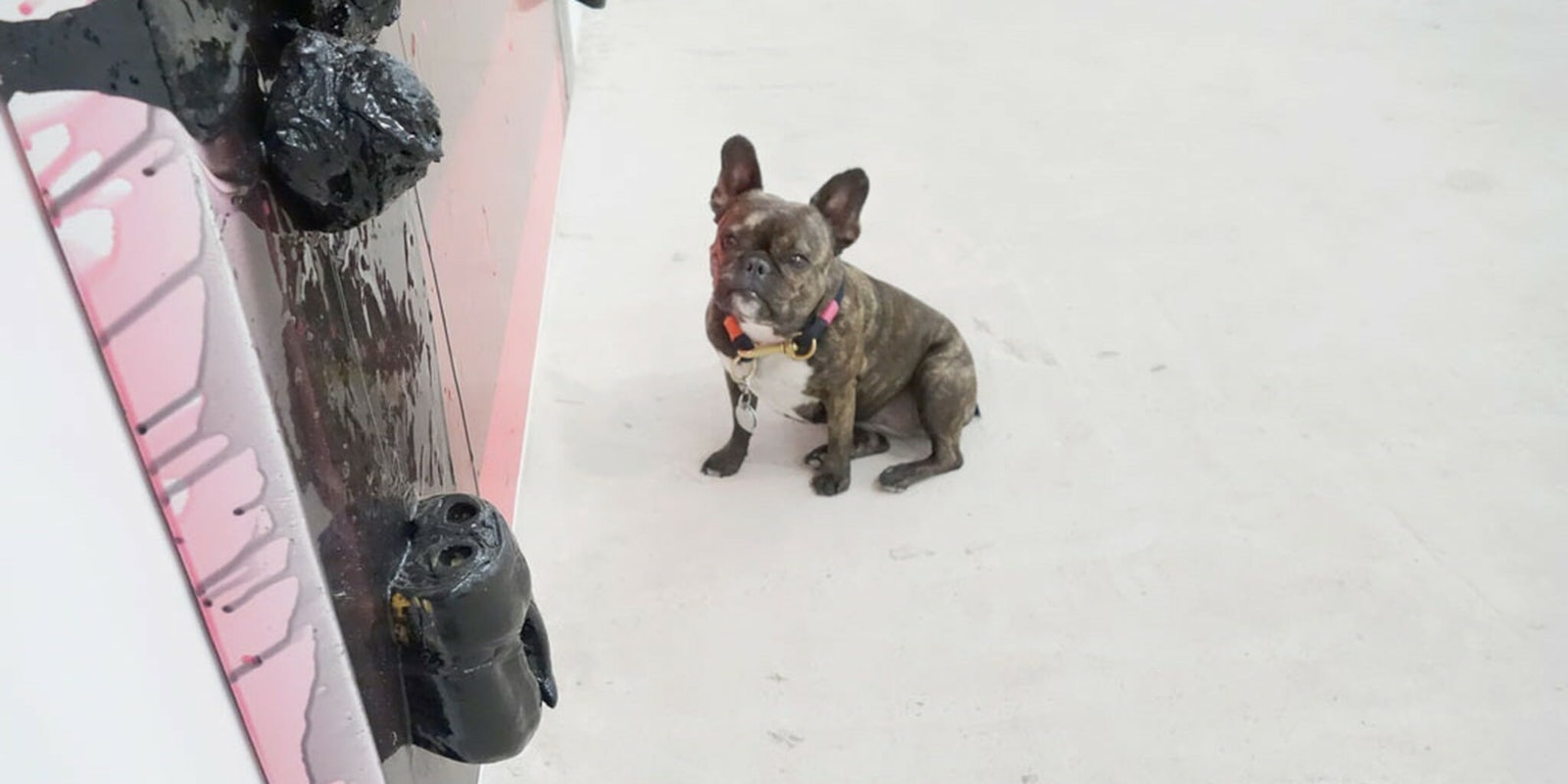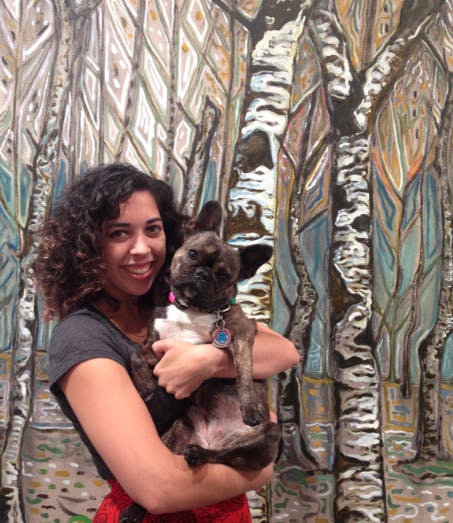As Miss Pickle effortlessly sat for another photo at the Bortolami Gallery in Chelsea, in between two gorgeous embroidered canvases by Ivan Morley, two other art lovers cooed from across the room.
“We thought she was part of the art!” one exclaimed, as Miss Pickle trotted over and nestled into his hand. According to Miss Pickle’s owner, Katie Howard, this happens all the time. As we left, they asked if she was on Instagram.
Little did they know.
Miss Pickle is the art-loving French Bulldog of Instagram. With about 7,500 followers, she is nowhere near as famous as some other Instagram celebrities, human or canine, but then again, Miss Pickle isn’t trying to be any ol’ Instagram celebrity. She’s more than just a cute face. She’s a conduit into the insular world of contemporary art.
While we were out, Pickle seemed particularly fond of a piece made of stitched, embossed leather that hung low to the ground, sniffing it as Howard made sure that’s as far as the interaction went. Pickle isn’t always picky about art, but does seem fond of anything that reminds her of other animals.
“She really reacts to taxidermy, obviously,” Howard said.
Howard doesn’t take her photos in front of any old artwork. There’s a curation that must take place. “It’s a struggle to fight with the white walls of the galleries, because everything starts to look the same,” she said. “The art is different, but if you’re scrolling through Instagram, it looks monotonous.”
So she seeks out art that is low to the ground, colorful, or can be photographed in other interesting ways. “When you can really see the art and Pickle’s face is the best,” she said. “Sometimes I’ll sacrifice the entire piece of art so you can see her face in detail.” She also keeps her eye out for art that Pickle can react to, like the leather piece, or any pieces that are on her eye level.
It’s a difficult balance to strike, since not all art Instagrams well. It’s the double-edged sword of social media: it facilitates connections, but on its own terms. In a visual medium such as Instagram, if it doesn’t photograph well, it doesn’t work. Still, Howard finds ways to incorporate plenty of artists and mediums. A large part of the project is showcasing what’s happening in New York’s contemporary art scene, and introducing it to people who don’t have as much familiarity.
“The issue with contemporary art is there’s a lot of in crowd signaling,” she said. “There are too many people trying to make themselves feel cool and smart, and that dynamic has really pushed away a lot of the general public, who otherwise would want to engage with it.”
It’s not new for the art “scene” to seem insular and intimidating to those on the outside, but social media has begun to break down those barriers. Now, people around the world can see what’s going on in Chelsea’s galleries, even if all they thought they were signing up for was cute photos of dogs.
Howard isn’t focusing on monetizing Pickle the way others in the Instagram pet machine are, though she admits it’s quickly feeling like a full-time job. She has dreams for a glossy coffee table book of Pickle in the art world a few years down the line, and right now is working on a partnership with Love Thy Beast, a company that makes canvas dog carriers.
“I loved how the canvas tote mimicked these art world canvas totes that everyone carries,” she said, so she reached out, and is now in the process of finding artwork to feature on the sides of a line of bags. Again, it’s about being an access point to art. “There’s not going to be a whole lot of people who know who these artists are outside the art world,” Howard explained, “but if the artists do designs on one of these tote bags, their names will be out there to more than just this community.”
It’s very easy to be jealous of Pickle. As we walked from gallery to gallery, both employees and visitors flocked to her, petting her and commenting on how well-behaved and calm she was. She spent the morning looking at art, then sat next to us in a Chelsea cafe drinking water, eating a free snack from the waitress, and watching other dogs go by. “I think she knows people know who she is, and she gets a lot of attention, but I don’t know if she realizes that’s not normal,” Howard said.
Miss Pickle exists in two bubbles. According to Howard, we are in a contemporary art bubble, a “time of intense and diverse purchasing from collectors and buyers.” We’re also in an Instagram-famous pet bubble. In Racked, Kyle Chayka cataloged the Internet’s most famous pets, who pick up hundreds of thousands of followers, and their owners have begun to quit their jobs and seek fortunes online. If you’re going to make it as an Internet celebrity pet owner, now’s the time. But that bubble has to burst, if only because, well, dogs don’t live that long. “It’s really sad to think about, but it’s going to be interesting to see what happens with that,” she said.
Perhaps that’s why Pickle is so intriguing. The project goes deeper than “my dog is cute.” Every Instagram comes with information about the artist, the gallery, the show you could be seeing right now, this culture you could be a part of if you decided. It’s what Instagram does best: present an idealized fantasy world that just looks so good. Of course, working in the art world is like any other job with its ups and downs, but for Howard and Pickle, sometimes it is that good.
As we left the cafe, I asked Howard to do me a solid: let me get a photo with Pickle. She happily obliged, and brought us to another gallery showing one of her favorite shows right now. The employees happily greeted Pickle as we walked in, let us peek at some new art in a private room, and pose in front of the captivating canvases. As I walked back to the subway, I imagined that could be my life, walking the streets of Chelsea, learning about art, and hanging out with an adorable dog. It’s a fantasy worth living. Image via ArtBlogDogBlog



